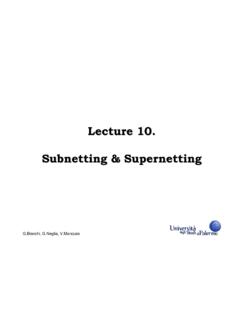Transcription of IP Subnetting and Related Topics - cju.com
1 IP Address Subnetting Chris Uriarte IP Subnetting and Related Topics A Tutorial by Chris Uriarte Updated April 2001 IP Addresses and their Binary Equivalents First and foremost, it s important to understand that every IP address has a binary number equivalent. We use the binary equivalents to compute subnet information. It s very important that you are comfortable with simple binary math, especially binary addition and converting decimal number to their binary equivalents. For example, the IP address has a binary equivalent of: 11001110. 00010100. (11001110 represents 206; 00010100 represents 20; 00100100 represents 36; 00000001 represents 1) We say that each IP address is composed four groups of eight bits, ranging from 00000000 to 11111111 (binary). Therefore, IP addresses fall into the range: to (binary) or the decimal equivalent: to (in reality, we don t actually assign IP addresses starting or ending with 0 or 255 to ll learn a bit more later).
2 IP Address Classes There are three general classes of IP address blocks: Class A - supports 16+ million hosts on each network Class B - supports 65,000+ hosts on each networks Class C - supports 254 hosts on each network Organizations can be assigned classes of IP addresses based on their needs. For example, an organization can be allotted the IP address block of * (where * represents any valid number), which includes the IP addresses to (256 IP addresses total). The IP block * is considered a Class C network. As another example, a company may be allotted the IP address block *.*, which includes the IP addresses to (65K+ addresses total). *.* is considered a class B network. Useable IP Addresses On a Network Although a Class C network contains a total of 256 IP addresses ( to , for example), there are actually only 254 IP addresses that can be assigned to hosts on the network. This is because there are 2 special IP addresses in each network that cannot be assigned to hosts.
3 IP Address Subnetting Chris Uriarte The Network Address is the first address on a subnet and is essentially used to identify the network (think of it as the name of network). In the Class C network *, is the network address. The Broadcast Address is the last IP address on a subnet and represents an all hosts address, utilized to send packets to every host on a subnet . In the Class C network *, is the broadcast address. Therefore, given a subnet that contains a total of N IP addresses, the total number of IP addresses you can assign to hosts is N-2. Subnetting : Dividing IP Networks Into Smaller Blocks A subnet is a portion of a network that shares a common address component with other portions of the network. On TCP/IP networks, subnets are defined as all devices whose IP addresses have the same prefix. For example, all devices with IP addresses that start with would be part of the same subnet . Dividing a network, such as a Class B or Class C network, into subnets is useful for security and performance reasons, as well as for reasons of practicality.
4 As noted before, a Class B network contains a total of 65K+ IP addresses, while a Class C network contains 254 IP addresses. Since IP addresses must be assigned to organizations in blocks, what happens if a an organization requires only 500 IP addresses??- too many IP addresses for a Class C network, but far too little addresses to justify the use of an entire Class B network. This is a prime example of why we use bubnetting. In this example, we can divide a Class B network into smaller blocks, or subnets, to accommodate the need of 500 addresses. IP networks are divided into subnets using a subnet mask. A subnet mask is used to determine what subnet an IP address belongs to. An IP address has two components: the network address and the host address. For example, consider the IP address Assuming this is part of a Class B network, the first two numbers ( ) represent the Class B network address, and the second two numbers ( ) identify a particular host on this network.
5 Subnetting enables the network administrator to further divide the host portion of the address into two or more subnets. The combination of a network address (explained earlier) and a subnet mask tell us exactly the IP addresses contained within a subnet . For example, the network address with a subnet mask of tells us that the IP addresses in this subnet are to Given the fact that we cannot assign the first address in the block (the network address) or the last address (the broadcast address) to hosts, the useable IP addresses in this subnet are to The next step is to explain how we actually calculate subnets and subnet masks. Calculating subnet Information A. Given an IP address and a subnet mask, determine its associated network address. Determining a subnet s network address from an IP address and a subnet mask is quite simple. We simply execute the following steps: 1. Convert both the IP address and subnet mask to their binary equivalents.
6 Line each digit up so they evenly match on paper. We usually place the IP address above the subnet mask. If either 8-bit block does not contain 8 digits, you must pad the front of the 8-bit block with zeros until the block becomes 8 digits. Given the IP address and a subnet mask of , we have: IP Address: IP Address Subnetting Chris Uriarte subnet Mask: 2. Now apply the Bitwise AND operation on each corresponding digit in the IP Address and subnet Mask. The Bitwise AND operation is a function that compares two numbers and returns true, or 1, if both numbers are true. In the binary number world, the Bitwise AND operation produces results according to the chart below: Number 1 Number 2 Bitwise AND Result 0 0 0 0 1 0 1 0 0 1 1 1 So, for this example, we compare each digit in the IP address with the digit directly below it in the subnet mask. If they are both 1, the Bitwise AND result is 1. IP Address: subnet Mask: Bitwise AND Result: 3.
7 Finally, convert the Bitwise AND result to from Binary to Decimal format. The example above, gives us the address of , which is the network address associated with our IP address and subnet mask above. Example A: Given an IP address of and a subnet mask of , what is the network address associated with this subnet ? 1. Convert (IP Address) and ( subnet Mask) to binary: IP: Mask: 2. Perform the Bitwise AND operation between the corresponding digits in each address: IP: Mask: Bit. AND: 3. Convert the Bitwise AND result into decimal format to its decimal equivalent of this is the network address. B. Given an IP address or Network Address and a subnet mask, determine the usable IP addresses in the subnet . This scenario is commonly encountered when you know the IP address and subnet mask of a host on the network, but are unsure of what IP addresses you can assign to other hosts on your network. There are several ways to figure out subnet IP address ranges in a Class C network through manual calculations and table lookups.
8 I will demonstrate both methods. IP Address Subnetting Chris Uriarte First, let s examine the manual procedure, which, again, utilizes simple binary arithmetic: 1. First, convert each IP address (or network address) into their binary forms. Line each digit up so they evenly match on paper, as we did earlier. Remember, if either 8-bit block does not contain 8 digits, you must pad the front of the 8-bit block with zeros until the block becomes 8 digits. Given the IP address and a subnet mask of , we have: IP Address: subnet Mask: 2. Given the IP address and subnet comparison above, we now need to break the IP address bits into a host portion and a network portion. You will notice that every subnet mask begins with a series of 1 s. The IP address s bits that correspond to ( are directly above) the subnet mask s 1 s are part of the network portion of the address these are the bits that are common to all hosts in this particular subnet .
9 The IP address s bits that correspond to the 0 s in the subnet mask are part of the host portion of the address these are the bits that uniquely identify each host in the subnet . In the example above, I have separated the host portion of the addresses from the network portion. The network portion appears in blue, while the host portion appears in red. IP Address: subnet Mask: 3. Next, we want to figure out exactly how many IP addresses are in each subnet of this Class C. To do this, we count the number of bits contained in the host portion of our address. In the address above, the magic number is 6, since we have 6 host bits. We now compute 2 to the 6th power to determine how many IP addresses are in each subnet : 26 = 64 Therefore, each subnet in this class C contains 64 IP addresses. In addition, it is now easy to compute just how many subnets are contained in this Class C, given the subnet mask above. Common sense tells you that if there are 256 IP addresses in a Class C block, you must have (4) blocks of 64 IP addresses.
10 However, you can also count the number of bits in the subnet portion after the last decimal point in the IP address, or subtract your magic number above, 6, from 8 (8 6 = 2). Now we raise 2 to the 2nd power to get the number 4, which represents the number of subnets in the class C. You may start to notice a pattern here: if you extend the network portion of the address (make the subnet mask larger), you increase the number of subnets in a class C, but decrease the number of IP addresses in each subnet . For example, if we extend the subnet mask one additional bit in the example above, this class C will contain 23, or 8, subnets of 32 hosts. 4. Now that you know that there are 64 hosts in each subnet of class C * you can begin to make a chart of the subnet blocks in the class C, keeping in mind that the first IP address in a Class C starts with zero: subnet Blocks in Class C * with subnet mask of : IP Address Subnetting Chris Uriarte to to to to Notice that we created 4 subnets containing 64 IP addresses in each.









